Inbound Marketing Checklist: 10 Growth Strategies for 2022 


Want to grow your relationship with your audience while simultaneously crushing your growth goals?
Then you need to invest in inbound marketing.
If you’re running any kind of business in 2022, be it a software company, retail brand or anything in between, inbound marketing will make your job a whole lot easier.
With inbound, you’ll help potential customers discover your brand online, rather than going out there and finding them yourself.
Over time, this leads to better ROI, higher conversion rates, a greater number of qualified leads, and more sales.
Inbound marketing is powerful stuff.
But unlike outbound marketing where budget makes a big difference, inbound is about strategy and commitment. You have to truly understand your customers and create genuine value if your inbound strategy is going to pay off in the long run.
That’s what we’re here to help you do.
In this article, we’ll cover off everything you need to know to build and run a successful inbound marketing program.
Whether you’re just starting out or looking to take your game plan to the next level in 2022, this article will help you grow faster and more effectively with these 10 inbound marketing growth strategies:
- Identifying campaign audience
- Setting goals and benchmarks
- Creating an irresistible offer(s)
- Making landing pages
- Plan and build your automation and nurturing flows
- Write a blog post and share it on social media
- Add in long tail keywords
- Consider paid search and other channels
- Tracking your URLs
- Report on the results of your inbound efforts
Ready? Let’s go.
What is Inbound Marketing?
Inbound marketing is a business methodology that’s focused on helping potential customers discover your brand and company at each stage of the customer journey. With inbound marketing, your goal is to build meaningful and lasting relationships with your target customers by providing them with information of value or solving a problem they may have.
Inbound marketing works extremely well at the Awareness stage of the customer funnel, long before your audience is ready to make a purchase. However, it can also be incredibly useful in engaging, converting, and retaining your customers.
Inbound vs. Outbound Marketing
Inbound marketing involves using ‘pull’ marketing methods to attract customers to your business, such as content creation, SEO, social media, events, and partnerships. These tactics are built upon helping your target audience organically discover your brand by addressing challenges or solving problems that they’re already looking for. Do this enough, and these customers will be more likely to trust and engage with your business in the future.
Outbound marketing, on the other hand, uses ‘push’ marketing methods to deliver your brand, message, and products to your target audience. These are often unsolicited forms of marketing — think PPC, email newsletters, or YouTube ads — and may not be content that your customers necessarily want at that stage in time.
The benefits of inbound marketing
While both inbound and outbound marketing have their place in a digital strategy, inbound marketing can be far more powerful for awareness, engagement, conversion and retention.
Inbound marketing puts your customers’ needs front and centre and connects you to your audience in a way that’s genuine and authentic. When your customers don’t feel like they’re being sold to, they’re more likely to share your content and connect with your brand.
This methodology also allows potential customers to organically come to you, rather than you needing to go out there and seek them out. A rock-solid inbound strategy will save you from constantly needing to search for new leads, because they’re coming to you.
These leads will also be more qualified, which helps boost conversion rates and cut downtime across the sales cycle.
Another great thing about inbound?
While these tactics are more labour intensive, they’re less demanding on your budget — which means you’ll see a higher ROI from your efforts.
Need more reasons to add inbound marketing to your arsenal? The figures don’t lie:
- 79% of companies that have a blog say they get positive ROI from their inbound marketing.
- 80% of key decision makers prefer to get information from articles than an ad.
- Inbound marketing is 10x more effective for lead conversion than outbound marketing.
The Essential Inbound Marketing Checklist
Most businesses, regardless of the industry, can benefit from some form of inbound marketing. But, as we touched on earlier, your strategy and tactics need to be well thought out and executed if you want to maximise your inbound marketing efforts.
There are a few essential components that every inbound program should tick off if it’s going to truly make a difference in your business. Follow this checklist below to ensure your inbound marketing game plan is on-point and geared for success.
1. Identify your campaign audience
Before you jump into creating blog posts or building a social media program, you need to get to know your audience — and we mean REALLY know them.
Inbound marketing is all about providing genuine value for potential customers, and you can’t do this without understanding:
- who they are
- what they need
- the issues they face, and
- their communication preferences.
Start out by pulling all the data you can on your target audience. Look at your Google Analytics Audience insights to understand who is coming to your website, where they’re coming from, and the type of content that they’re interested in:
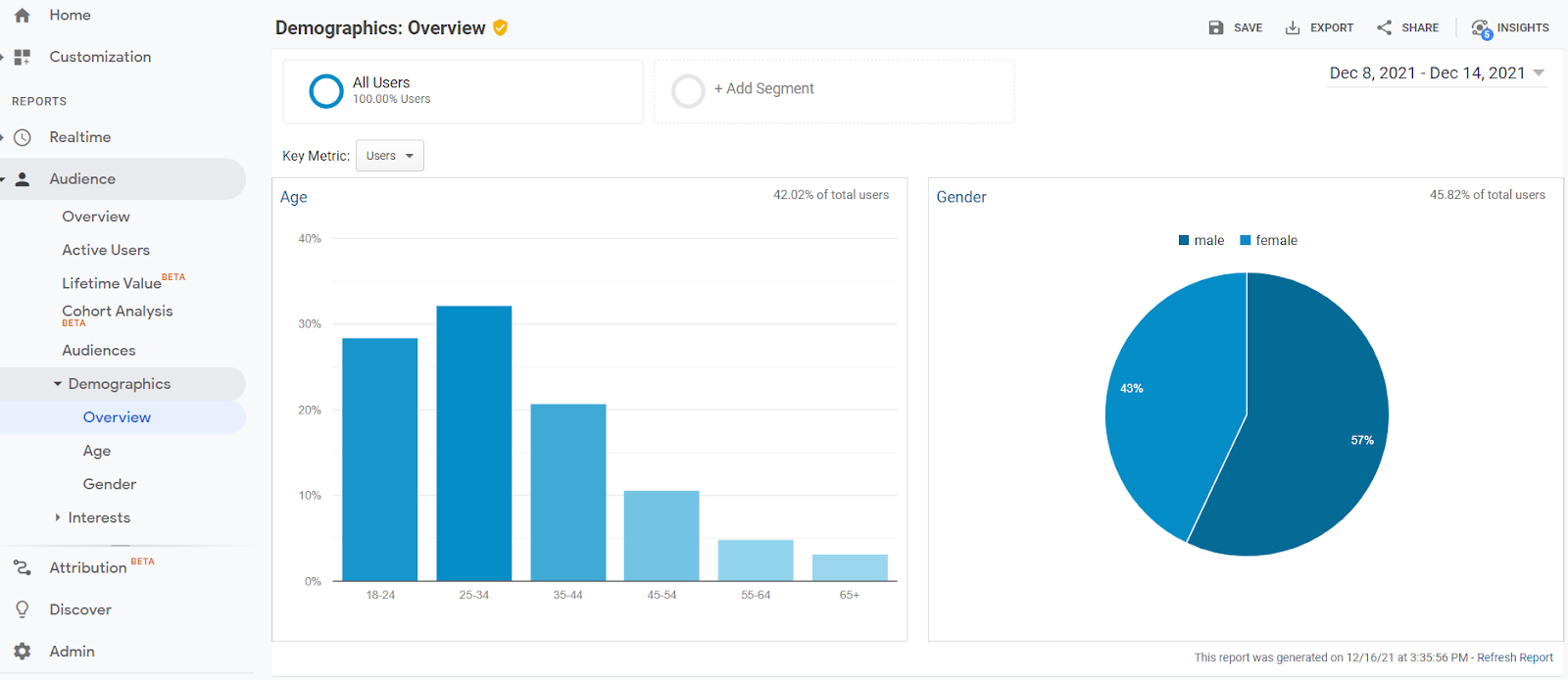
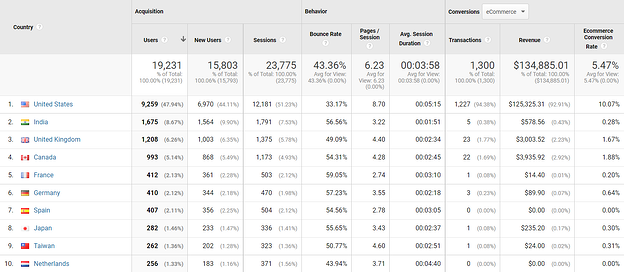
Supplement this with social media analytics from platforms like Facebook, Instagram and LinkedIn, as well as any other data points you might have, such as customer surveys.
Once you’ve got all this information sorted, you can start shaping your customer personas. Try to create multiple personas based on your target audiences, and make them as in-depth as possible. If you don’t have one already, this template from HubSpot is a great place to start:
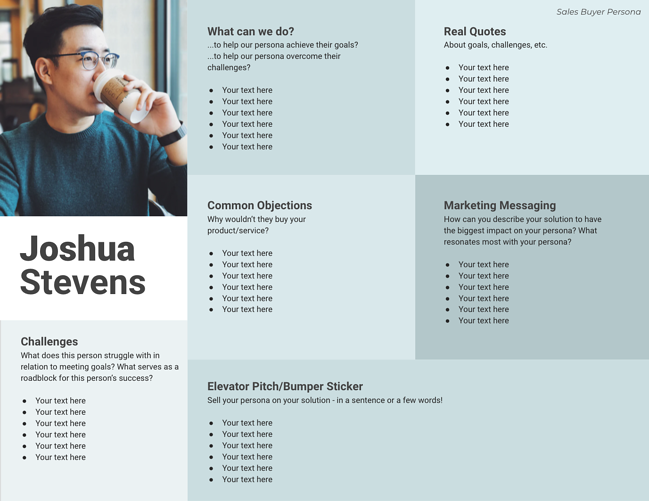
2. Set your goals and benchmarks
Got your target audience locked in?
Great. Now it’s time to set objectives for your inbound marketing campaign. But in order to do that, you first need to take the time to truly understand your current position and where you want to go.
Here are some thought starters to consider when mapping out your game plan:
- What marketing activities are we currently doing?
- Aside from cold calling, what activity does our sales team spend most of their time doing?
- Where is our marketing team spending most of their time?
- How are we reporting and tracking performance?
- Which activities have delivered the outcomes we wanted? Why?
This will give you a clear idea of where to focus your time and energy when it comes to your inbound marketing strategy.
For example, if your sales team is spending the majority of their time following up on emails to prospects, you might be able to automate this and free up more time.
Similarly, if eBooks have worked well for you in the past but you’ve only done a handful, it’s worth looking at making this a regular activity in your marketing calendar.
After you’ve got a handle on these, get ready to nut out goals and benchmarks.
Like any objectives, you need to make sure that your goals are S.M.A.R.T. if you’re going to be able to track and measure success. This means they need to be:
- Specific: Be clear on exactly what it is you want to achieve with your inbound plan. Is the goal to grow leads by 10%? Double your website traffic? Increase conversion rate by 1%? Being specific with your goals means you’ll be able to have a clear picture of what you want to achieve and what it takes to get there.
- Measurable: Measurement needs to be at the heart of every inbound strategy. Set initial benchmarks for all of your key tactics — these could be from industry averages or based on your previous results, if you have them.
- Achievable: Make sure that your goals and your roadmap are attainable with your existing resources and timeframe. Remember: you can always adjust and set new targets if you end up hitting your KPIs early. Another option is to set a realistic goal and a stretch goal, so you and your team know exactly what you’re shooting for.
- Relevant: This goes back to your inbound marketing M.O. What do you want to achieve, and what figures will reflect success? For example, if your overall objective is to increase revenue for your business, your primary targets shouldn’t be geared towards improving your blog visitors. Likewise, if your focus is on awareness, your main targets should be linked to top-of-funnel metrics like website traffic and blog views.
- Time-specific: Your goals should be tied to a certain time frame — in other words, they need a start date and an end date. Having fixed timelines will ensure you stay focused and committed to your objectives, and you have a clear point where you’ll stop and evaluate the results from your campaign.
One last thing: it always, always, ALWAYS pays to rally your team around a shared goal. This could mean setting an overall target — such as increasing revenue by 15% in Q1 2022 — then breaking this down into smaller goals by department, or simply sharing the goals with the entire company.
3. Create an irresistible offer(s)
Behind every successful inbound marketing campaign, there’s a compelling offer. These should:
- Be linked back to your original campaign goal
- Give your potential customers a reason to take action
Let’s say you’re aiming to increase leads from your website.
Another option could be to offer a free trial of your product or service for a fixed period of time, like what Cash Flow Frog does for their accounting software:
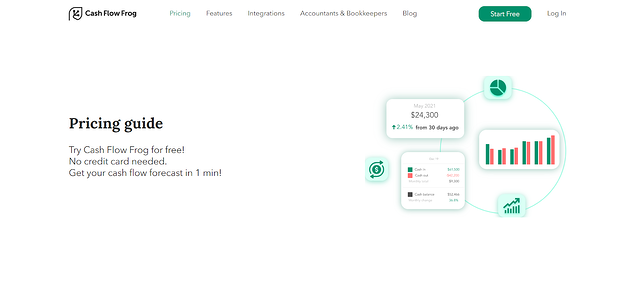
The key to any good offer is to provide value to your customers, whether it’s a free trial, valuable insights and tips, or exclusive pricing. Think about the problems they’re trying to solve, then work backward to create an offer that helps address these challenges.
4. Build money-making landing pages
Once you’ve got your offer(s) locked and ready to go, you need to build a persuasive landing page for that offer.
A compelling landing page significantly increases the success of your inbound marketing campaigns for one simple reason: it gets your target audience to take action and convert.
So what goes into a money-making landing page?
Clean and uncluttered design
Your landing page should offer just enough information to pique your audience’s interest, and no more. Lengthy landing pages can overwhelm potential customers or cause them to give up and head elsewhere for information.
Keep the design simple and straightforward, with the most important information and call-to-action located above the fold. Meal delivery service Blue Apron does this well with their landing page: any user landing on the page instantly knows how it works and has a compelling reason to sign up for $60 off.
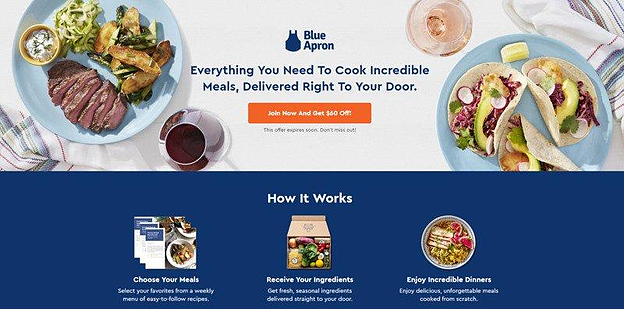
Hubspot is another great example of inbound landing pages done right. The company’s landing page features clear copy that conveys the platform’s unique features, provides a preview of the tool, and a compelling offer to get started for free — all without the user needing to scroll down.
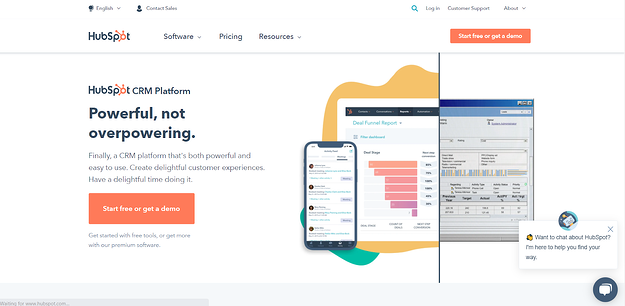
Hook people in with your headline
The headline is the single most important piece of copy on your entire landing page. You only have a limited amount of time to capture your user’s interest, and the message you choose to lead with can be the difference between sky-high sign-ups and sky-high bounce rates.
A powerful headline should:
- Grab the audience’s attention
- Be concise and easy to read
- Confirm your offer and/or value proposition to your audience
- Feature power words or tangible outcomes (for example: “Claim your free digital marketing audit worth $2,000” or “Increase sales by 20% in one month”).
Lyft does a great job with this on their driver sign-up page. The headline includes a clear benefit for the reader — making $1,650 in 30 days guaranteed — while also being hyper-specific with location-based messaging.
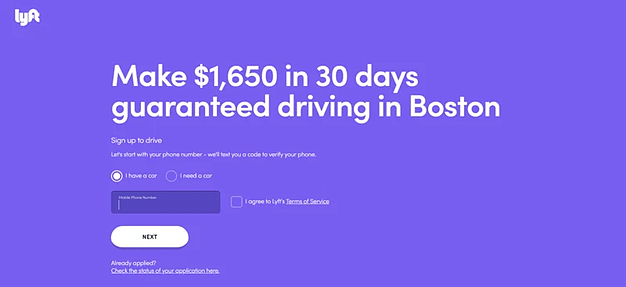
Use social proof to back up your claims
The number one goal of any inbound marketing campaign is to build a relationship with your potential customers. And that relationship? It starts with trust and good word-of-mouth.
See, any business can rave about themselves.
But a genuinely valuable business doesn’t do that — instead, they let their customers do the talking.
There are a number of ways you can go about using social proof on your landing pages. You can feature customer reviews and user numbers like Knovio:
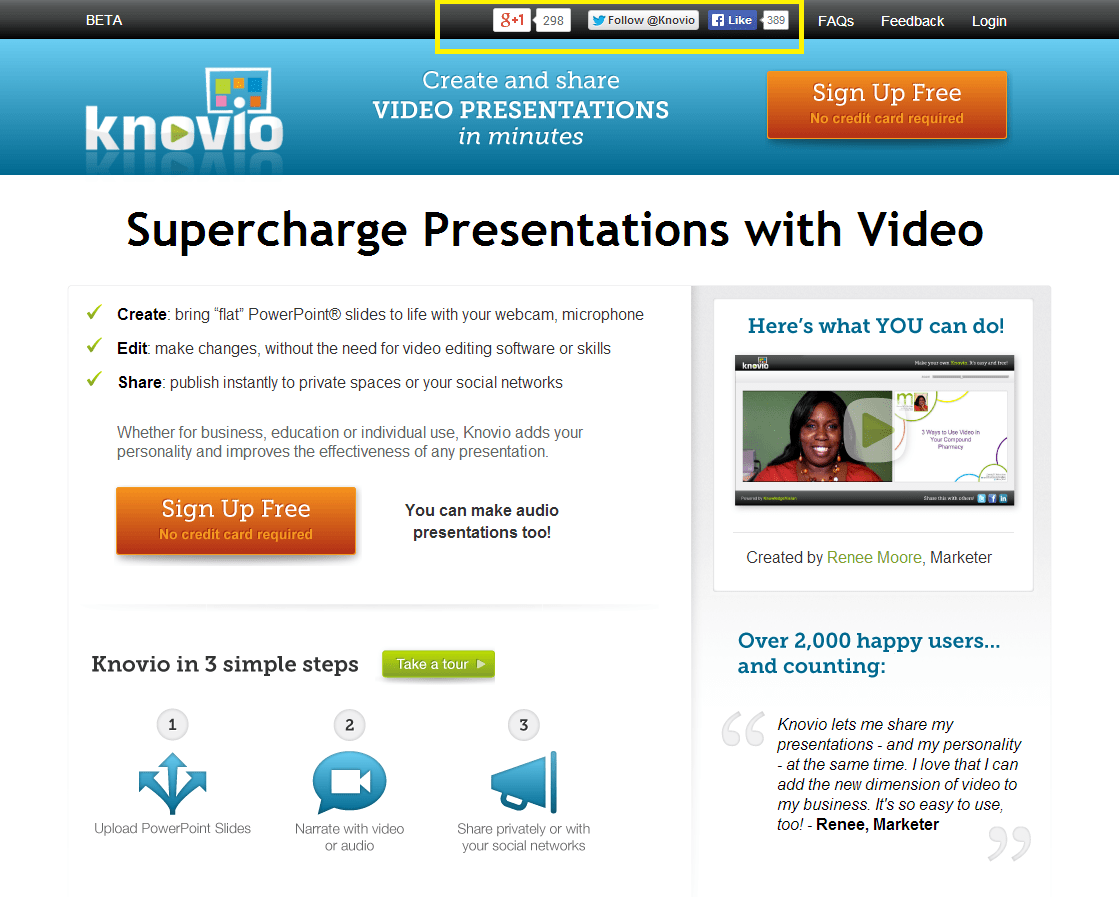
Or add in figures from case studies like Klientboost:
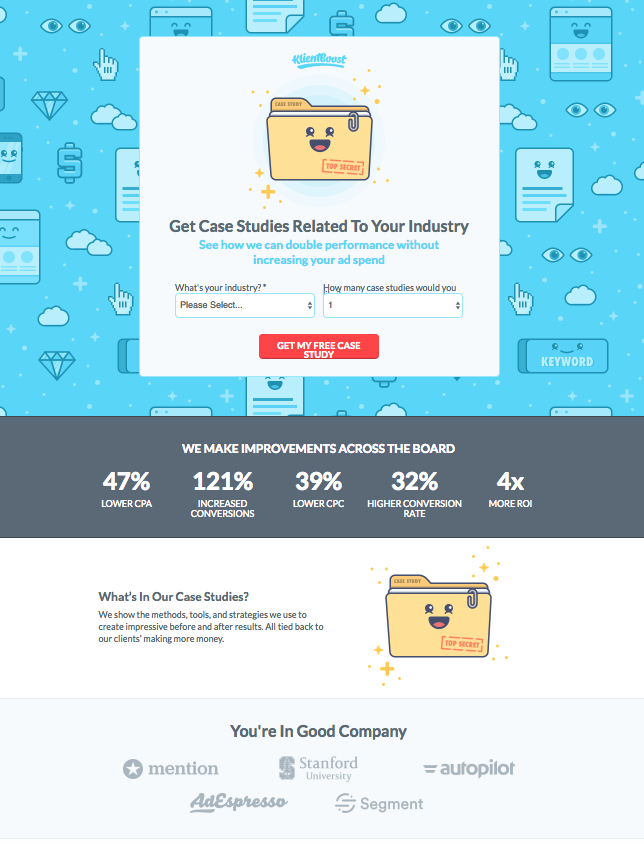
Another helpful tip for designing landing pages is to include client logos and trust badges whenever possible. This simple inclusion has been shown to increase landing page conversions by as much as 32.6%.
Be on form with your form design
Nobody — we repeat, nobody — likes filling out long and tedious forms. Most marketers go overboard when designing their inbound marketing forms and ask for WAY too much information which, in turn, can drive customers away.
In fact, you can improve your conversion rates by as much as 50% simply by cutting down your form fields from 4 to 3.
When designing your form, only ask for the information you need to know. While it might be tempting to capture as much data as possible, don’t forget that any customer information is better than none at all.
For example, this form by Kissmetrics makes sign-up as frictionless as possible by only including one field:
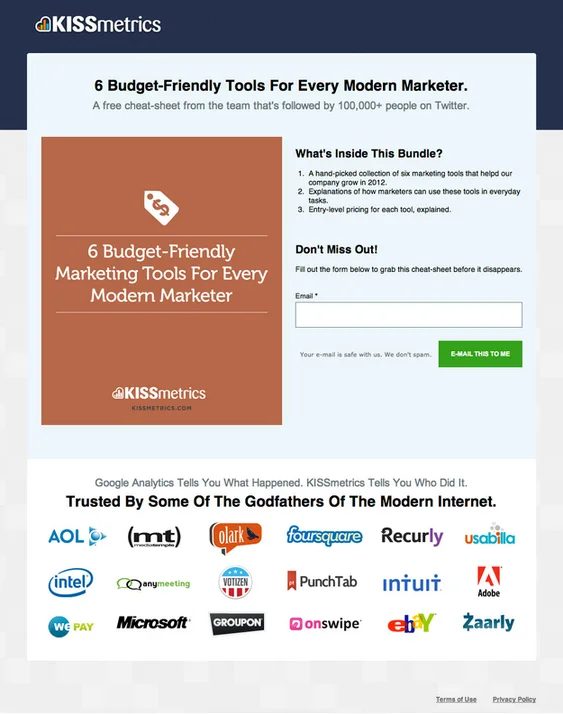
Another approach is to allow users to save time and log in using their existing social media accounts, like what Hootsuite has done:
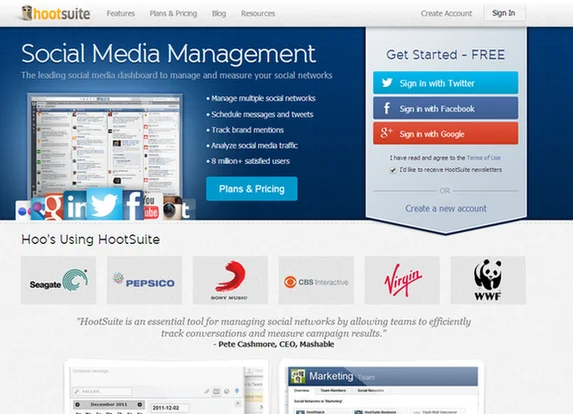
Here are some other tips for creating great forms:
- Use radio buttons to minimise the amount of typing your customers have to do
- Use directional cues, such as arrows
- Design your forms for mobile and desktop
- Include a clear CTA on every form
- Run A/B tests to ensure every element on your form is optimised for conversions
Create multiple landing pages for different audiences
A final word: it’s worth building more than one landing page as part of your inbound marketing strategy. Businesses with 30+ landing pages generate 7x more leads than those with fewer pages, purely because they have more targeted messaging on each landing page.
If you have the time and resources, build different pages for different types of customers, different acquisition sources, or for different phases of the customer journey.
If you have even more time on your hands, be sure to check out our landing page blog article featuring 34 high-converting examples and best practices here.
5. Plan and build your automation and nurturing flows
Automated email marketing flows are an essential part of any good inbound marketing campaign. Done well, automated emails can:
- Educate your customers and nurture them from awareness to engagement and conversion
- Increase conversion rates at each stage of the marketing funnel
- Enable you to send targeted messages based on customer behaviour
- Help retain loyal customers and increase their lifetime value
- Improve communication between you and your audience
- Save time and make life easier for your sales team
If that wasn’t enough to convince you, the Epsilon Email Institute found that automated emails have a 70.5% higher open rate and 152% higher click-through rate than traditional marketing messages.
At the bare minimum, you should have these workflows set up in your email marketing platform:
Welcome email series
This campaign allows you to build on that initial excitement and momentum that occurs just after a person signs up for your email newsletter. A report by Bluehornet found that 3 in 4 users expect a welcome email after signing up for an email newsletter. Use this campaign to introduce your brand, your history, and your products or services, like HubSpot:
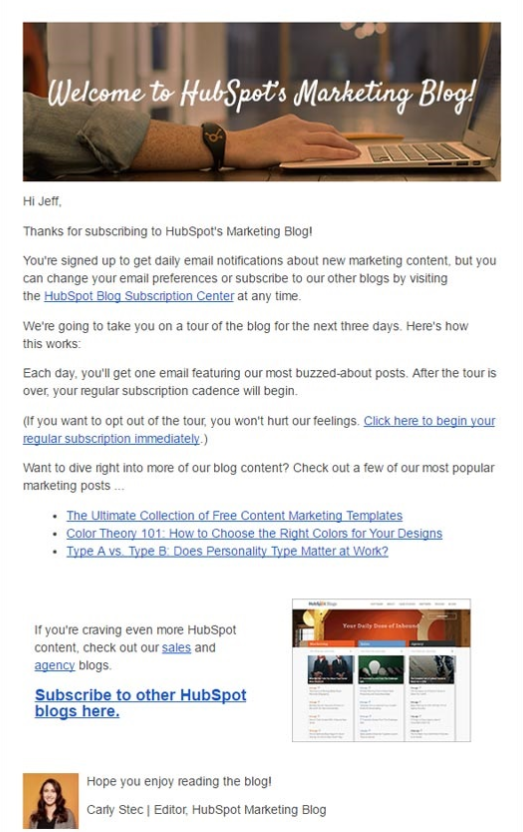
Lead nurturing campaign
The goal of getting any new contact into your email database is to build up trust, keep them engaged, and move them closer on their path to conversion. One valuable way to do this is by ‘nurturing’ your relationship with your audience as they move through your email program. This might start out with a friendly introduction email, followed by an educational email, then an email with an invitation to book a call or sign up for your product/service.
Automizy does a great job of this with its lead nurturing program. They start off with a friendly welcome email and free report:
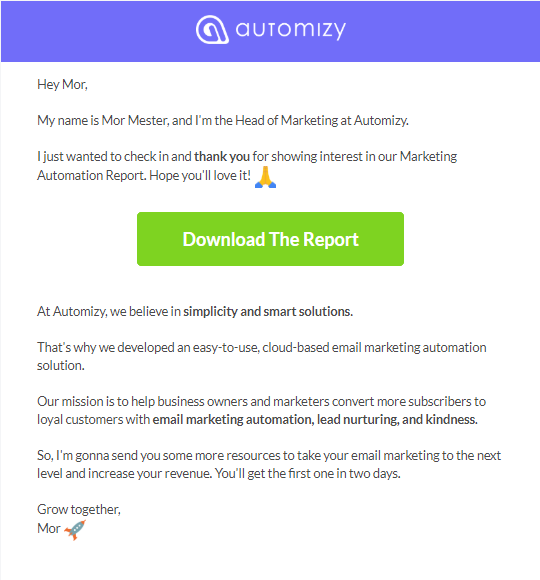
They then follow this up by creating valuable content and sending it to their audience:
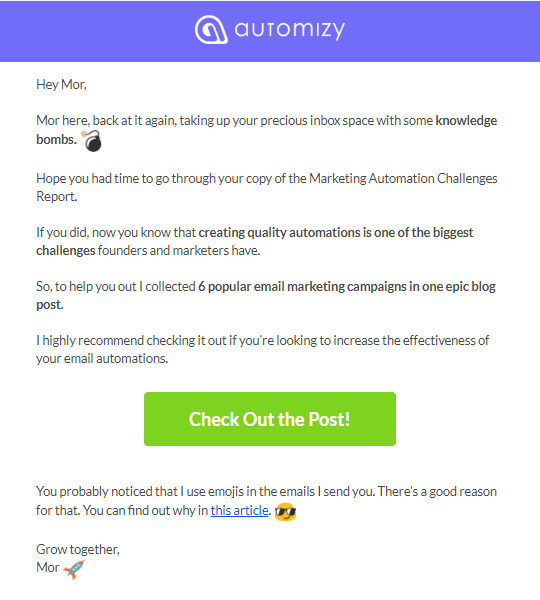
And finish it off with an invitation for a free trial:
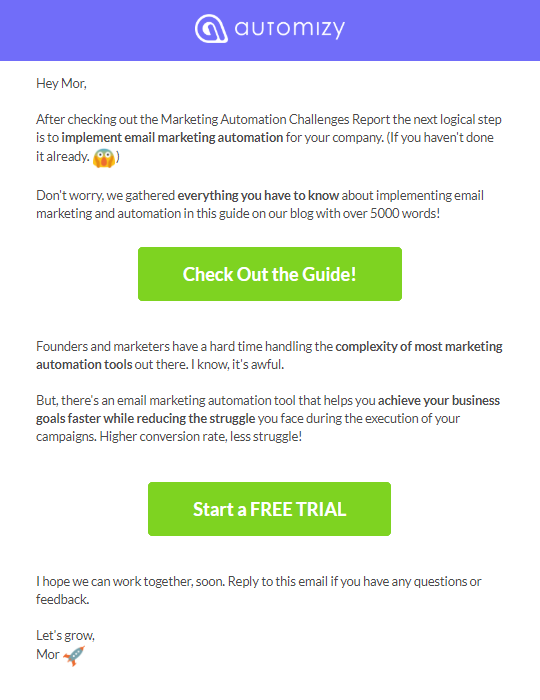
Upsell and cross-sell
Email automation campaigns aren’t just for new customers. You can also use your workflows to sell more to your existing customers, such as an upgrade to their existing product or a recommendation for another product that you offer. For example, if an insurance company sold car insurance to a client, they might then choose to follow that up with an email recommending their contents insurance or health insurance products.
Here’s an example of an upsell email from Vimeo:
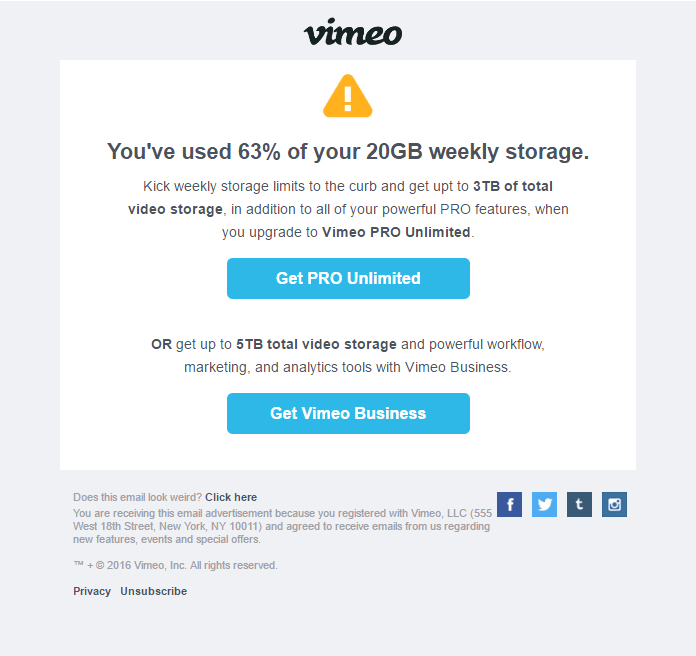
Other email marketing workflows you might choose to have include:
- Milestone emails for customers on their one year anniversary, birthday, or other key events
- Re-engagement campaigns for previous customers who have cancelled their service
- Customer surveys to gather feedback after an interaction with your brand or using your products and services
Finally, no matter which workflow you’re developing, pay attention to the order and timing of your emails. Each of these emails is its own mini customer funnel, so you need to ensure the information you’re delivering is clear, concise, and geared towards providing value for your customers at each stage of their journey.
6. Write a blog post and share it on social media
It doesn’t matter what industry you’re in — content marketing is a fundamental pillar of any inbound marketing program. And we can’t talk about creating content without talking about blogs.
Blogs are an invaluable tool to bring traffic to your website, establish your authority within your industry, build up trust with your audience, and convert clicks into qualified leads and sales. Chew on this: companies with blogs generate 67% more leads per month on average than companies that don’t blog. Blogging is also integral to your SEO efforts: having a blog on your site can boost your chances of appearing in organic search engines by as much as 434%.
The key with blogging is to ensure your blog posts are solving challenges that your customers have. You can find relevant topics to blog about by looking at Google Trends, checking out up-and-coming topics on Reddit or BuzzSumo, or by browsing through search demand for different keywords.
It’s not just enough to blog, either. You need to spread the word and distribute relevant content to your social media followers or email subscribers — otherwise, your valuable content won’t be working as hard as it could for your business.
7. Add in long tail keywords
Long-tail keywords are responsible for more than 70% of all searches conducted on Google. If you want to increase organic search traffic, improve your SEO rankings in search engine results and accelerate your inbound marketing efforts, you need to weave these search terms into your landing pages and blog posts.
So how do you find these keywords?
Start by looking at a topic that’s relevant to your business — for example, “car hire”. Plug this into one of your SEO tools, such as SEMrush, and you’ll instantly be able to conduct additional keyword research based on this initial seed keyword:
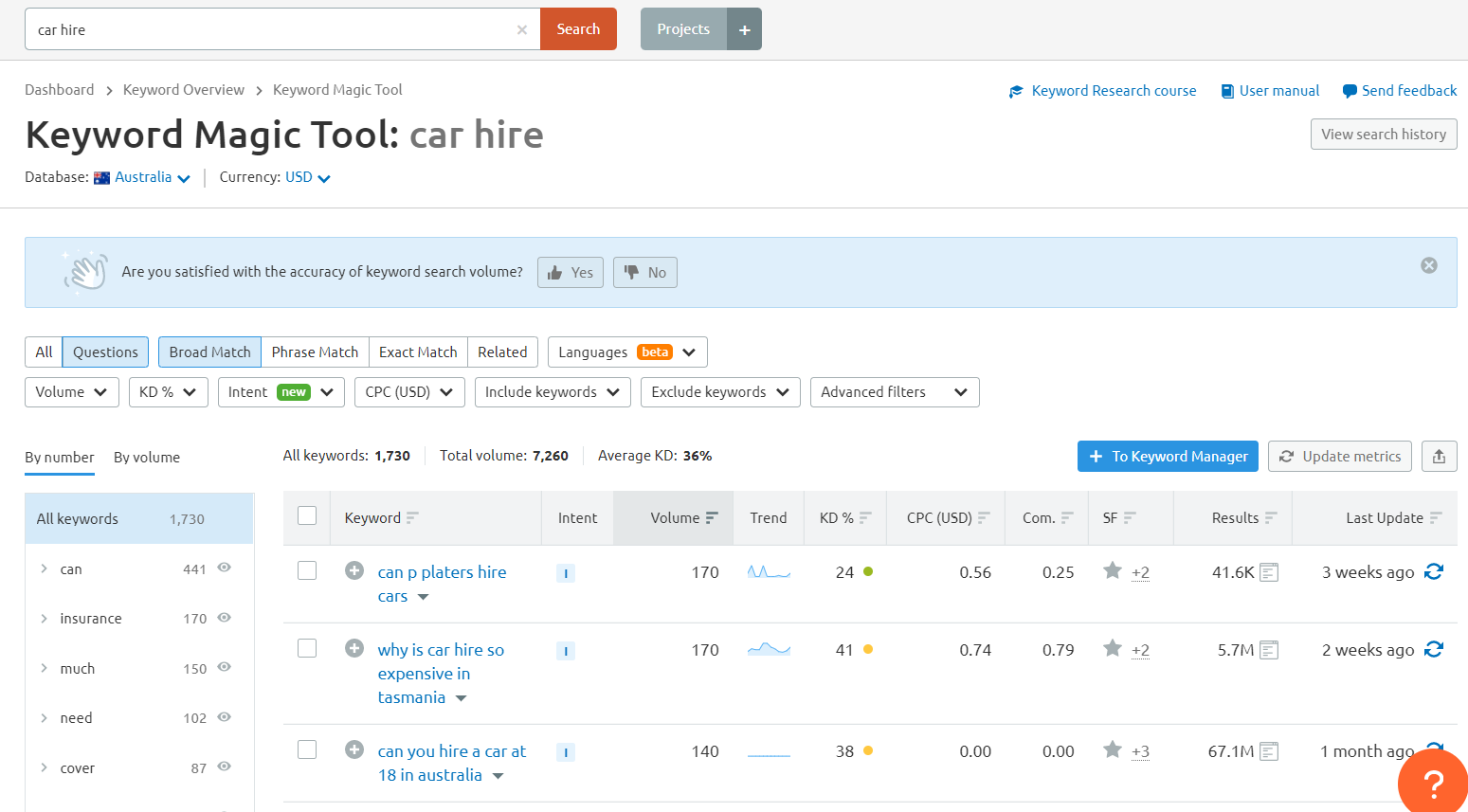
Don’t just stick to phrases either. Take a look at question-based keywords in Ahrefs, SEMrush or even in the “People also ask” section of Google to find more opportunities to rank for popular long-tail search terms.
Once you have your long-tail keywords, add them to your landing page or blog, or consider creating a dedicated piece of relevant content for that specific search term. Lastly, don’t stuff as many keywords as possible into your website. Instead, focus on one group of semantically related long tail keywords for each landing post or blog for the best results.
8. Consider paid search and other channels
While inbound marketing is mainly focused on tactics like SEO, content marketing and social media, you can dramatically improve the performance of your inbound marketing campaigns with outbound methods.
Sounds counterintuitive?
Far from it.
Think about it this way. If you’re creating quality content, such as an eBook or a blog post that’s focused on solving a pain point for your customers, you want it to reach as many people as possible. With paid search, display or email marketing, you’ll amplify its reach and maximise its value — all while growing your brand awareness amongst your target market.
Depending on your industry and customers, some paid media channels you could incorporate include:
- Paid search or display advertising to direct people to your lead generation form or lead magnet
- Retargeting existing prospects who have already demonstrated an interest in your website, blogs or resources
- Email marketing to spread the word about your content to your database
- Paid social media marketing on Facebook, Instagram or LinkedIn that promotes your content
9. Track your URLs
If you don’t track your inbound marketing, you’ll never really know how you’re stacking up versus your benchmarks or goals. Make sure you’re tracking performance on all your landing pages and campaign URLs.
There are two ways to go about this, depending on what you’re trying to track. You can either add a UTM parameter to the end of your URL, which looks like this:
?utm_source=google&utm_medium=display&utm_campaign=spring-release&utm_term=rugs&utm_content=help-guide
All you need to do is head over to Google Analytics and use their Campaign URL builder to generate this link.
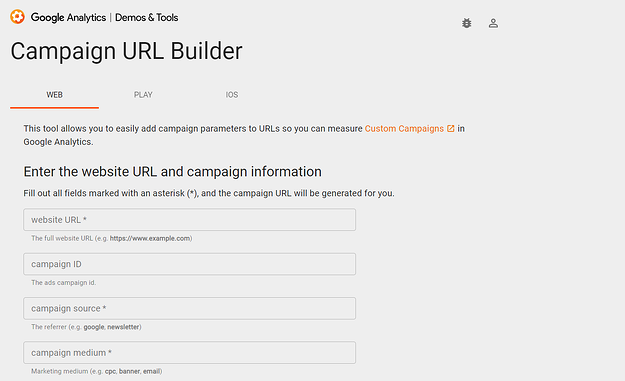
Alternatively, you can track button clicks on a form using Google Tag Manager.
10. Report on the results of your inbound efforts
You should be regularly tracking your results based on the goals and objectives you defined at the beginning of your campaign.
Schedule regular times to review your results: are you hitting your targets? Have you made any analytics tracking mistakes? Are there any areas where you need to concentrate your efforts in the future? Do you need to set new goals? It’s also worth getting your sales team in the same room to discuss how your campaigns are translating into leads, the quality of leads, and any areas of improvement.
Create an effective inbound marketing campaign that’s bound for greatness
Inbound marketing is about knowing your audience, then taking the time to truly solve their problems and provide value to their lives. More importantly, having laser-focused inbound marketing strategies benefit every aspect of your sales funnel, from your SEO strategy and brand awareness to your lead pipeline and your overall sales.
But inbound is just one part of a solid online marketing strategy.
You need to know how to combine your inbound marketing focuses with traditional outbound marketing if you want to achieve explosive growth year in and year out.
That’s where we can help.
Our gurus will craft a solid game plan to naturally attract inbound traffic AND maximise your marketing budget with outbound marketing. With both strategies working for your business, you’ll knock your sales and revenue goals out of the park.
Here’s the best bit. It’s absolutely FREE to get started. Simply click on the link below to claim your free digital audit (worth $2,000).









